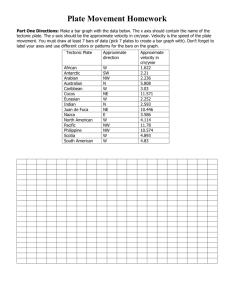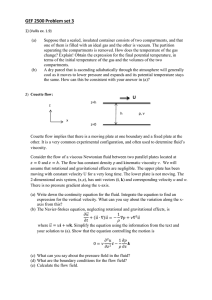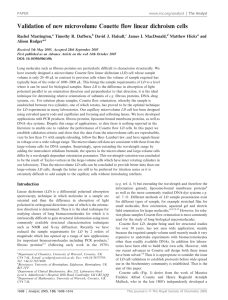2.011 Homework #7
advertisement
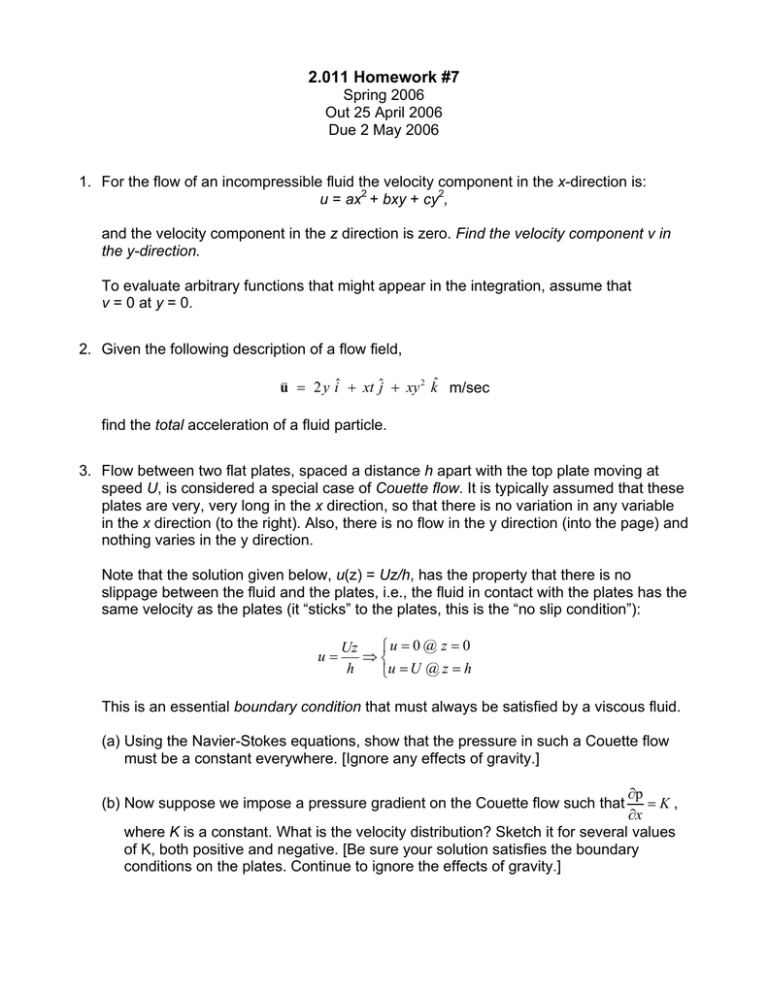
2.011 Homework #7 Spring 2006 Out 25 April 2006 Due 2 May 2006 1. For the flow of an incompressible fluid the velocity component in the x-direction is: u = ax2 + bxy + cy2, and the velocity component in the z direction is zero. Find the velocity component v in the y-direction. To evaluate arbitrary functions that might appear in the integration, assume that v = 0 at y = 0. 2. Given the following description of a flow field, K u = 2 y iˆ + xt ĵ + xy 2 kˆ m/sec find the total acceleration of a fluid particle. 3. Flow between two flat plates, spaced a distance h apart with the top plate moving at speed U, is considered a special case of Couette flow. It is typically assumed that these plates are very, very long in the x direction, so that there is no variation in any variable in the x direction (to the right). Also, there is no flow in the y direction (into the page) and nothing varies in the y direction. Note that the solution given below, u(z) = Uz/h, has the property that there is no slippage between the fluid and the plates, i.e., the fluid in contact with the plates has the same velocity as the plates (it “sticks” to the plates, this is the “no slip condition”): u= ⎧u = 0 @ z = 0 Uz ⇒⎨ h ⎩u = U @ z = h This is an essential boundary condition that must always be satisfied by a viscous fluid. (a) Using the Navier-Stokes equations, show that the pressure in such a Couette flow must be a constant everywhere. [Ignore any effects of gravity.] ∂p =K, ∂x where K is a constant. What is the velocity distribution? Sketch it for several values of K, both positive and negative. [Be sure your solution satisfies the boundary conditions on the plates. Continue to ignore the effects of gravity.] (b) Now suppose we impose a pressure gradient on the Couette flow such that 3. continued… (c) For the Couette flow with pressure gradient, what is the shear stress Txz on each plate? In a sketch, show its direction for positive and negative values of K. 4. A baseball is travelling north for a distance of 60 feet at a velocity of 75 miles per hour at Fenway Park in Boston. (a.) Calculate the direction and magnitude of the deflection of the baseball due to the Coriolis acceleration. (b.) How does your answer to part (a) change if the ball is thrown east? south? west? (c.) How does your answer to part (a) change if the ball was thrown in Wellington, New Zealand? (d.) How does your answer to part (a) change if the ball was thrown in Quito, Ecuador? (e.) How does your answer to part (a) change if instead the ball is thrown at 100 miles per hour? Note: The approximate latitude of Boston is 42◦N, the approximate latitude of Wellington, New Zealand is 42◦S, and Quito lies approximately on the Equator. 5. The Southern Ocean (surrounding the Antarctic Continent) is normally driven by strong winds from West to East (clockwise around Antarctica). Describe and show in sketches: • the direction of the Ekman transport • the effect of the Antarctic Continent on the Ekman motion, the sea-surface slope, and the pressure; • the influence of the Ekman transport on the N-S density gradient; • the resulting geostrophic flow in the near-surface water. Do not (re)derive fundamental relationships that are discussed in detail in the lecture notes. For example, do not repeat the Ekman analysis here, but be sure to explain how the general conclusions of the Ekman analysis lead to certain conclusions in your sketch(es) and similarly for the other parts of the question. You will need to present two figures (basic sketches/cartoons are sufficient), (i) a map (plan) view of a sector of the Antarctic/Southern Ocean area and (ii) a vertical crosssection of the ocean near the Antarctic Continent. You should show and explain features such as upwelling, downwelling, convergence, and divergence (if they occur). Where is the water relatively cold or warm and how does that affect the pressure gradient, slope, etc.?

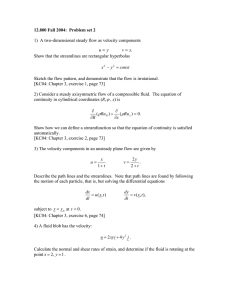
![Hints to Assignment #7 -- 8.022 [1] Transforming velocities](http://s2.studylib.net/store/data/013604148_1-3d9271f99177c85a7e62a5b153f4c4ea-300x300.png)
